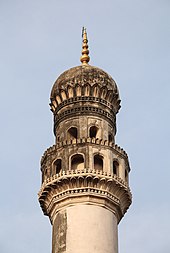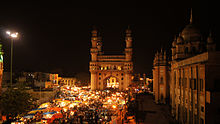Design and construction
The Charminar was constructed in the intersection of the historical trade route that connects the markets of Golconda with the port city of Masulipatnam. The Old City of Hyderabad was designed with Charminar as its centerpiece. The city was spread around the Charminar in four different quadrants and chambers, seggregated according to the established settlements. Towards the north of Charminar is the Char Kaman, or four gateways, constructed in the cardinal directions. Mir Momin Astarabadi, Qutb Shah's prime minister, played a leading role in preparing the layout plan for the Charminar along with that of the new capital city, Hyderabad. Additional eminent architects from Persia were also invited to develop the city plan. The structure itself was intended to serve as a Mosque and Madraasa. It is of Indo-Islamic architecture style, incorporating Persian architectural elements.
Structure
The Charminar is a square structure with each side 20 meters (approximately 66 feet) long, with four grand arches each facing a fundamental point that open into four streets. At each corner stands an exquisitely shaped minaret, 56 meters (approximately 184 feet) high, with a double balcony. Each minaret is crowned by a bulbous dome with dainty petal-like designs at the base. Unlike the Taj Mahal's, Charminar's four fluted minarets are built into the main structure. There are 149 winding steps to reach the upper floor. The structure is also known for its profusion of stucco decorations and the arrangement of its balustrades and balconies.
The structure is made of granite, limestone, mortar and pulverised marble. Initially the monument with its four arches was so proportionately planned that when the fort was opened one could catch a glimpse of the bustling Hyderabad city, as these Charminar arches were facing the most active royal ancestral streets.
There is also a legend of an underground tunnel connecting the Golkonda fort to Charminar, possibly intended as an escape route for the Qutb Shahi rulers in case of a siege, though the location of the tunnel is unknown.
A mosque is located at the western end of the open roof; remaining part of the roof served as a court during the Qutb Shahi times. The actual mosque occupies the top floor of the four-storey structure. A vault which appears from inside like a dome supports two galleries within the Charminar, one over another, and above those a terrace that serves as a roof, bordered with a stone balcony. The main gallery has 45 covered prayer spaces with a large open space in front to accommodate more people for Friday prayers.
The clock on the four cardinal directions was added in 1889. There is a vazu (water cistern) in the middle, with a small fountain for ablution before offering prayer in the Charminar Mosque.
Surroundings
The area surrounding Charminar is also known by same name. The monument overlooks another and grand mosque called the Makkah Masjid. Muhammad Quli Qutb Shah, the 5th ruler of the Qutb Shahi dynasty, commissioned bricks to be made from the soil brought fromMecca, the holiest site of Islam, and used them in the construction of the central arch of the mosque, hence its name.
A thriving market exists around the Charminar: Laad Baazar is known for jewellery, especially exquisite bangles, and the Pather Gatti is famous for pearls. In its heyday, the Charminar market had some 14,000 shops.
Influences
In 2007, Hyderabad Muslims living in Pakistan constructed a small-scaled quasi replica of the Charminar at the main crossing of theBahadurabad neighborhood in Karachi.
Lindt chocolatier Adelbert Boucher created a scaled model of the Charminar out of 50 kilograms of chocolate. The model, which required three days' labour, was on display at The Westin, Hyderabad, India on September 25 and 26, 2010.







